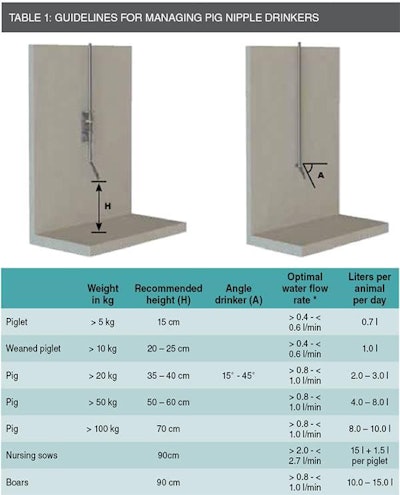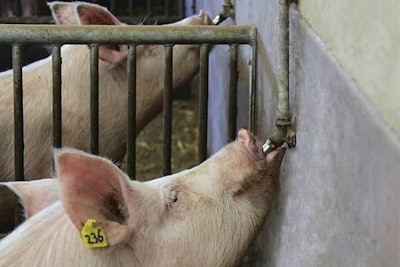
At birth, the body weight of a piglet is 82 percent water. By the time the pig reaches market weight at 100 kg, water comprises only 51 percent of its total body weight components. This proves how important water is throughout the life of a pig, as it comprises more than half of its weight.
During the first week of life, a piglet mainly drinks milk from the sow. Soon after the first week, however, the piglet starts drinking water. Often the water available to piglets through the water supply system is stagnant and warm. Oxygen combined with water can become a source of bacterial infection, such as MRSA, when temperatures exceed 20C (68F). It is therefore very important that the water in the water supply system be cleaned and disinfected before usage.
Research shows that piglet feed intake increases when they start drinking water at an early age, resulting in a higher weight per piglet. In general, growing pigs drink three times more water than they eat dry feed. A farrowing sow drinks at least 20 litres of water a daily, depending on the climate and environmental conditions. When a sow has difficulty standing up, reduces her feed intake, shows symptoms of constipation, and piglets can only suckle when she stands, then alarm bells should go off: the sow is not drinking enough.
How to choose the appropriate drinking system
When selecting a drinking system, it is important to look at the environment, housing system, temperature, feed and body weight of the pigs. Providing drinking water at a temperature below 20C (68F)enables adequate intake during hot conditions. In addition, it is important to provide enough drinking opportunities in each pen. Some pigs continuously intimidate other pigs, preventing them from reaching the drinking point. Therefore, at least two drinkers are recommended for pigs in a group.
A wide variety of nipple drinkers are available. Bite nipples, wet feeding nipples and spray nipples are the most commonly used pig nipples. Wet feeding and spray nipples are mounted in troughs. Bite nipples are mounted at an angle of 15-45 degrees, the height dependent on the height of the pigs. For detailed information see Table 1.

Nipple positions in the pen
The height and position of pig drinkers depend on the type of nipple, type of pig house and the age of the pigs. Nipples are generally mounted 5 centimeters above shoulder height for the smallest pig. In practice, however, it is not feasible to measure all the pigs and adapt the height of the nipples continuously. Therefore, bite nipples are mounted on the wall at a fixed height within a given range. In some pig houses a few pig drinkers are mounted at various heights to make sure that every pig has easy access to the drinkers.

Nipple drinkers should be placed 5 centimeters above shoulder height. | Laura van Santen
Drinkers should not be mounted in the corner of the pen. As pigs feel safer near walls to defecate, a drinker in a corner would increase spoilage. The ideal place to mount a drinker is close to a feeder. When placing two drinking troughs, place them close to each other. If they are too far apart, one will most likely be unused and become dirty, which is a health hazard.
Optimal flow rate
It can occur that the first nipple in the pig house has a greater water supply than the last one. This can give difficulty in providing each pig the desired amount of water. It may also result in incorrect medicine dosages being delivered to each pig. To achieve the desired water flow rate from the first to last nipple of the water supply system, a special water pressure regulator can be mounted on the pig nipple drinker.
Drinking patterns
Research indicates that pigs have a distinct drinking pattern. Finishing pigs and sows drink mostly between 3 and 9 p.m. with a second peak between 5 and 11 a.m. Gestating sows drink mostly between 8.30 a.m. and 5 p.m., and lactating sows drink during the entire day to produce enough milk. Knowledge of the drinking patterns of pigs is an aid to providing them with enough water during these peaks. The flow rate adjusted by an accurate regulator contributes to supplying pigs with enough water to drink what they require and to mature as healthy pigs.
In brief
Water is one of the most overlooked nutrition for pigs. Optimal water management contributes toward raising healthy and profitable pigs. The most common mistakes are irregular testing of the water, too few watering points and deviating water flow.

















